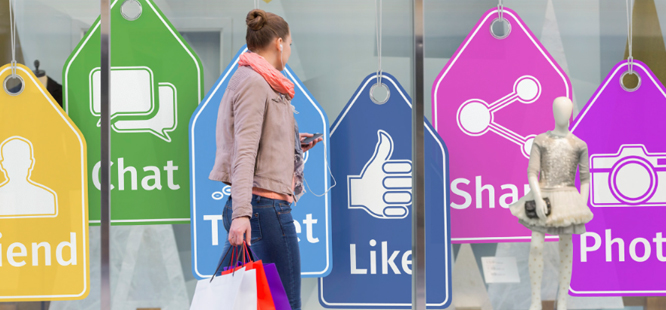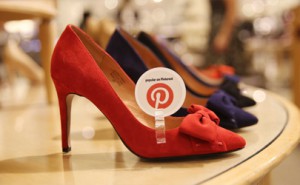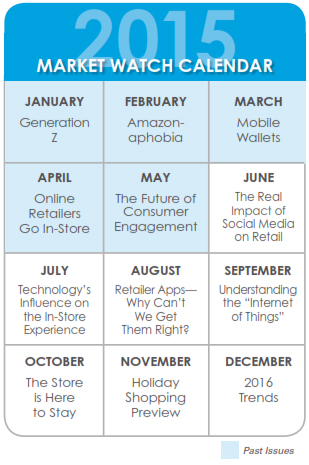
By Retail News Insider
When retailers and brands first made their way onto Facebook, Twitter, Instagram, Pinterest and other social media sites, many hoped each “Like,” Tweet or Share would be the surefire answer to increasing sales in the digital age. But some remained (and still stand) unconvinced—seeing social media as just another hype that would, in the end, have little impact their bottom lines.
As social media platforms have matured and become part of the mainstream landscape over the last decade (with nearly 75 percent of Americans maintaining at least one social media profile, according to analytics firm Statistica), the reality seems to be falling somewhere in the middle. It’s true that many retailers and brands have found it difficult to quantify the direct sales impact of each social media interaction. For example, Coca-Cola released a study in 2013 showing that social media mentions (or “buzz”) had no impact on short-term sales. Similarly, a 2013 study by technology firm IBM showed that less than 1 percent of visits to e-commerce sites come from social media referrals. But it’s beginning to appear these types of findings may be due more to the way ROI is being measured than to social media’s actual value.
So how do we know social media is important if we can’t always measure a direct sales link? For starters, consumers are telling us these interactions are important and can play a key role in many aspects of their path to purchase. For example, Interactions’ most recent Retail Perceptions study showed that 64 percent of consumers use social media to research products before buying them, and 58 percent have been introduced to new retailers via social media. What’s more, over 75 percent of social media users expect retailers to have a social media presence, and nearly half prefer to shop with those connect with them on social media versus those who do not.

Nordstrom combines social media with in-store merchandising efforts. Photo courtesy of Nordstrom, Inc.
In addition to survey results like these, many leading retailers are finding out first-hand how significant a role social media can play in their overall omnichannel strategies. Take leading fashion retailer Nordstrom, who has invested in a variety of new strategies over the past five years to integrate the online and offline shopping experiences. As part of that strategy, Nordstrom has developed one of the most engaging Pinterest campaigns in retail. Not only does the retailer encourage consumers to discover new items by cultivating and updating a variety of Pinterest boards, it also uses the feedback it receives on Pinterest to guide its in-store merchandising efforts. Each week, the retailer analyzes the most popular Pins and features those items prominently in its stores, tagging them with signs, cards and clips marked with the Pinterest logo.
“By deploying technology… that enraptures the shopper and acknowledges that they are walking around with technology in-hand [inside the store] anyway, the retailer boosts the consumer experience and serves to inform, entertain, and engage, leading to heightened shopper loyalty, increased revenue and happy shoppers,” says Lance Eliot, Vice President of Global IT for Interactions.
In addition to its robust Pinterest presence, Nordstrom was also one of the first retailers to offer a “Like2Buy” button on its Instagram feed. This allows users not just to like and comment on the retailers offerings, but to quickly see how much the product costs, what local stores its available in and/or to buy it online.
According to a recent case study featured in the Harvard Business Review, Nordstrom’s innovations in digital engagement have played a critical role in the over 50 percent revenue growth they’ve achieved over the past 5 years. This growth may not be solely the result of their social media campaigns. But as the Harvard Business Review authors note, it does reflect that their efforts to engage with and better serve the customers through all channels, including social media—and to keep an over 100-year-old company relevant in the digital age—have been rewarded with clear results.
Whole Foods is another good example of a prosperous national retailer who is successfully using social media to engage with and educate consumers. Like Nordstrom, Whole Foods places emphasis on tying its social media and in-store experiences together. Describing her role as Whole Food’s Director of Social Media and Digital Marketing, Natanya Anderson says that a big part of her job is “to figure out how we integrate all of [our local and brand level social media efforts] into our marketing campaigns, particularly the things that you see in our stores, so our customers have a holistic experience with us whether they’re in-store or online [between shopping trips].”
One way Whole Foods does this is by allowing each of its over 300 stores to have their own social media accounts, in addition to maintaining centralize corporate accounts. This allows the stores to post highly relevant, local content that shoppers can instantly connect with. For example, many local Whole Foods share upcoming events with their social media followers, which are specific to their individual stores. They also showcase products and recipes that are popular in their specific markets, from barbeque in Atlanta to ceviche in San Diego.
This strategy also enables Whole Foods to use social media as a local customer service tool. For example, want to know if your local Whole Foods has fresh, wild caught salmon in the seafood case that day? Save a trip to the store and send a tweet first to ask. Hoping they’ll carry your favorite energy bar? Take a photo and share it on Instagram. Chances are good you’ll get a reply.
 In its 2014 Annual Report, Whole Foods specifically points out that social media is a key component of its overall marketing and advertising strategy. “We generally invest less in paid media and marketing than other supermarkets—approximately 0.4% of our total sales in fiscal year 2014… [Instead] we benefit from valuable earned media, social media and word-of-mouth advocacy,” the report says.
In its 2014 Annual Report, Whole Foods specifically points out that social media is a key component of its overall marketing and advertising strategy. “We generally invest less in paid media and marketing than other supermarkets—approximately 0.4% of our total sales in fiscal year 2014… [Instead] we benefit from valuable earned media, social media and word-of-mouth advocacy,” the report says.
As for those brands and retailers who still question the value of social media, as noted previously, the issue may be more with what they expect for results. For example, a survey by small business directory provider Manta showed that only about 40 percent of small business owners who had invested in social media felt they were getting a direct ROI in terms of sales. But that’s not what retailers and brands who feel social media is worth the investment—and who have success with it—focus on. Instead, they look more toward the ROI of things like increasing their consumer base, engaging with consumers and improving brand image, according to a study by research firm Aberdeen Group.
Efforts that promote these types of benefits can be the keys to success for retailers and brands looking to establish or grow their own social media presence. As social-savvy retailers and CPGs like Nordstrom, Whole Foods, Target, Doritos, Oreo and others have shown, frequent, fresh content that engages with consumers on a personal level can drive success. These retailers and brands don’t just push the message they want consumers to hear; rather they encourage two-way conversation. They pose questions to consumers—for example, asking them to vote for their favorite #SuperBowlSnack. And they respond to shoppers’ concerns, openly and often within just a few hours or less.
By and large, the evidence shows that by engaging consumers, strengthening ties and promoting word-of-mouth advocacy over time, a carefully crafted social media presence can lead consumers down the sales funnel. It may take more time and come with a few extra twists, but in the end, the effort can pay off. The greater danger may lie in not making the effort at all, and simply leaving what the three out of every four consumers who will search for you on social media find up to chance.

